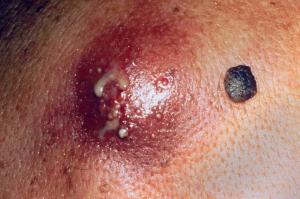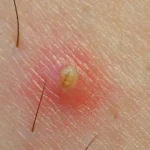A giant gluteal abscess is a large, painful, pus-filled infection located in the buttock region. It often results from bacterial infections, such as Staphylococcus aureus, and can lead to significant discomfort and complications if not promptly treated.
🩺 Medical Treatment of a Giant Gluteal Abscess
1. Incision and Drainage (I&D)
The primary treatment involves a minor surgical procedure where a healthcare professional makes a small incision in the abscess to allow the pus to drain out. This procedure is typically performed under local anesthesia and may require a drainage catheter to ensure complete evacuation of the pus.
2. Antibiotic Therapy
After drainage, antibiotics are often prescribed to combat the underlying infection. Common antibiotics include amoxicillin/clavulanate, cephalexin, and metronidazole, depending on the specific bacteria involved. The duration of antibiotic treatment typically ranges from 7 to 14 days.
3. Percutaneous Drainage
In certain cases, especially for deep or complex abscesses, percutaneous drainage may be performed. This involves using imaging guidance (such as ultrasound or CT) to insert a needle into the abscess cavity, followed by the placement of a drainage catheter. This method is minimally invasive and can be effective for abscesses located in the pelvic region.
⚠️ When to Seek Medical Attention
Immediate medical attention is necessary if you experience:
-
A painful, swollen lump in the buttock area
-
Fever or chills
-
Red streaks extending from the abscess
-
Signs of systemic infection
-
Rapid enlargement of the abscess
Prompt treatment can prevent complications such as cellulitis, sepsis, or chronic fistula formation.
🏠 Home Care for Small Abscesses
For minor abscesses, conservative measures may help:
-
Apply warm compresses to the affected area to promote drainage.
-
Keep the area clean and dry.
-
Avoid squeezing or attempting to drain the abscess yourself.
However, if the abscess is large, painful, or shows signs of infection, seek medical attention promptly.
A gluteal abscess is a serious localized infection under the skin in the buttock area. When large (“giant”), it needs prompt and effective medical management to avoid complications like sepsis or chronic fistula.
✅ 1. Immediate Solution (Short-Term Treatment)
🔹 Go to a Medical Facility
-
A large abscess cannot be treated at home. Immediate hospital or clinic evaluation is essential.
-
Delay can lead to systemic infection or tissue necrosis.
✅ 2. Definitive Medical Treatment
🛠️ A. Incision and Drainage (I&D)
-
Standard treatment for any large abscess.
-
Performed under local or general anesthesia, depending on size and pain level.
-
A sterile scalpel is used to open the abscess and drain the pus.
-
The cavity may be packed with gauze to prevent early closure and allow complete drainage.
-
In some cases, a drain tube (Penrose or catheter) is inserted for 2–3 days.
Reference:
💊 B. Antibiotic Therapy
-
Prescribed after drainage to treat or prevent surrounding cellulitis or deeper infection.
-
Typical antibiotics:
-
Amoxicillin-clavulanate (Augmentin)
-
Clindamycin
-
Metronidazole (especially if anaerobes are suspected)
-
TMP-SMX or Doxycycline (if MRSA is a concern)
-
Note: Antibiotics alone are not enough for a giant abscess — they’re only effective after drainage.
🧪 C. Culture and Sensitivity
-
Pus is often sent to the lab to identify the specific bacteria and guide antibiotic choice.
🔬 D. Imaging (for Deep or Complex Abscesses)
-
Ultrasound or CT scan may be used to:
-
Assess depth and extent of the abscess.
-
Guide needle drainage if surgery is high-risk.
-
Technique: CT-guided percutaneous drainage in some cases.
Reference: RadiologyInfo – Percutaneous Abscess Drainage
✅ 3. Aftercare and Wound Management
-
Daily wound cleaning with sterile saline.
-
Gauze dressing changes (sometimes twice daily).
-
Avoid pressure or sitting directly on the wound.
-
Monitor for signs of infection (fever, redness, increasing pain).
-
Wound may take 1–3 weeks to heal, depending on size.
✅ 4. Long-Term Solutions & Prevention
💡 A. Prevent Future Abscesses
-
Good hygiene: Regular washing and drying of buttocks area.
-
Avoid skin trauma: Friction, prolonged sitting in wet clothing.
-
Treat acne or folliculitis early to prevent it from becoming an abscess.
💉 B. Underlying Conditions
-
If you have diabetes, HIV, or a weakened immune system, manage these conditions as they increase abscess risk.
-
Chronic abscesses may require testing for hidradenitis suppurativa or Crohn’s disease.
❗When to Seek Urgent Care
-
High fever or chills
-
Spreading redness
-
Inability to sit or walk due to pain
-
Signs of systemic infection or sepsis


